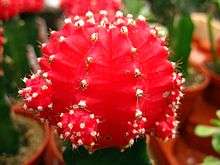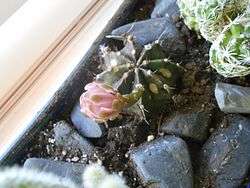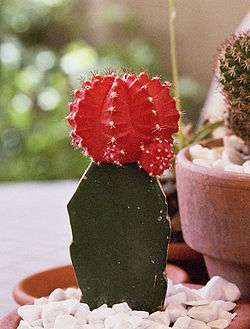Gymnocalycium mihanovichii
| Gymnocalycium mihanovichii | |
|---|---|
 | |
| Scientific classification | |
| Kingdom: | Plantae |
| Clade: | Angiosperms |
| Clade: | Eudicots |
| Order: | Caryophyllales |
| Family: | Cactaceae |
| Subfamily: | Cactoideae |
| Genus: | Gymnocalycium |
| Species: | G. mihanovichii |
| Binomial name | |
| Gymnocalycium mihanovichii (Fric ex Gürke) Britton & Rose | |
| Synonyms[1] | |
| |
Gymnocalycium mihanovichii, often called chin cactus, is a species of cactus from South America commonly grown as a houseplant. The most popular cultivars are varied mutants which completely lack chlorophyll, exposing the red, orange or yellow pigmentation. These cultivars are often called Moon Cactus, Ruby Ball, Red Cap Cactus, Red Hibotan or Hibotan.[2]
Background
Gymnocalycium mihanovichii is distributed in Paraguay and the northeast of Argentina and grows in low places up to 500 meters. The species was discovered there in 1903 by Alberto Vojtěch Frič.[3]
The first description as Echinocactus mihanovichii was published in 1905 by Robert Louis August Maximilian Gürke. Nathaniel Lord Britton and Joseph Nelson Rose placed it in the genus Gymnocalycium in 1922.[4]
Gymnocalycium mihanovichii is very variable, therefore numerous varieties have been described. Frequently found in culture are mutants of cultivated individuals - color forms that are viable only grafted, since they can hardly assimilate more or not , due to the lack of chlorophyll in the plant cells. In nurseries it is often then grafted onto another succulent plant Hylocereus – The most popular cultivars are mutants that do not contain chlorophyll at all, so that the underlying red, orange or yellow pigments become visible. Since chlorophyll is necessary for photosynthesis, these mutations die as seedlings unless grafted onto another cactus with normal chlorophyll.[5]
In the IUCN Red List of Endangered Species the species is referred to as "Least Concern (LC)", as not endangered.
Description
The individually growing Gymnocalycium mihanovichii have a broad-spherical, gray-green, often reddish overgrown plant body, which reaches stature heights and diameter of 3 to 5 centimeters. The usually 8 ribs are narrow-edged and slightly notched. The 5 to 6 weak, pliable and slightly curved thorns are greyish-yellow, between 0.8 and 1 centimeter long and partly fall off. The 4 to 5 cm long, bell-shaped to funnel-shaped flowers are yellowish-olive to light olive green. The light green stamens are in two rows. The stylus is also light green, the scar yellowish. The fruits are spindle-shaped.[6]
The species belonging to the "Hibotan" cultivar have a different color from the natural one because it is deprived of chlorophyll and, being unable to live on its roots, it is necessary that it is grafted onto another Cactacea which generally is Hylocereus.
Cultivars
Gymnocalycium produces offsets pretty easily, even when grafted, and the offsets so produced can be grafted to a new base, perpetuating the plant. Even the best grafts only last a few years, as the base grows faster than the Gymnocalycium. After that point, the difference in speed between the two becomes too great for the graft to hold together, and the two split apart. However, the scion can also be re-grafted back on to the rootstock after this.[7]
The coloured ones comprises a large group of popular mutants, characterized by more or less coloured bodies. They can be red, orange, purplish, yellow, or even white. The first totally decoloured mutants were called cv. 'Hibotan'. The first only partially de-chlorophylled were called cv. 'Hibotan Nishiki' and can grown on its own roots. The 'Nishiki' are all chlorophylled but with many anthocyanin and appear deep brown. By the time many other coloured were obtained and some have special name like 'Akagurohibotan-nishiki' or 'Pink-kuro'.[8][9]
Habitat
A number of Gymnocalyciums prefer shade in the wild, to be cloaked under shrubs or grasses, while others prefer abundant sunlight. As such, some may need covering from the sun in the hottest months, but exaggerating this will end up with loss of flowers. The balance of the potting medium should be adequate to allow decent drainage so that the plants do not sit in marshy soil for more than a day or two after watering. During summer months, the plant may need frequent watering, though those in small pots would need weekly watering. Nevertheless, the compost should be virtually dry before re-watering. Watering in the winter months is unnecessary.
Gallery
 Gymnocalycium mihanovichii friedrichii
Gymnocalycium mihanovichii friedrichii A mutant without chlorophyll, grafted on to a Hylocereus rootstock.
A mutant without chlorophyll, grafted on to a Hylocereus rootstock.- Close up
- Exemplary with a dragonfly
- Plant with fruit
- Plants in vase
- Flower
_na_podk%C5%82adce_Hylocereus_undatus).png) Yellow with blossom
Yellow with blossom
References
| Wikimedia Commons has media related to Gymnocalycium mihanovichii. |
| Wikispecies has information related to Gymnocalycium mihanovichii |
- ↑ "The Plant List: A Working List of All Plant Species".
- ↑ Nathaniel L. Britton; John N. Rose (1 June 1963). The Cactaceae. Courier Dover Publications. p. 153. ISBN 978-0-486-21192-3. Retrieved 3 September 2012.
- ↑ Edward F. Anderson: The Big Cactus Lexicon . Eugen Ulmer KG, Stuttgart 2005, ISBN 3-8001-4573-1 , p 320 .
- ↑ Curt Backeberg: The Cactaceae: Handbook of cactus science . 2nd Edition. Volume III . Gustav Fischer publishing house, Stuttgart New York 1983, ISBN 3-437-30382-1 , P. 1781
- ↑ NL Britton , JN Rose : The Cactaceae. Descriptions and Illustrations of Plants of the Cactus Family . Volume II . The Carnegie Institution of Washington, Washington 1920, p. 153
- ↑ Urs Eggli, Leonard E. Newton: Etymological Dictionary of Succulent Plant Names . Birkhäuser 2004, ISBN 3-540-00489-0 , p. 154
- ↑ D.G. Hessayon (1 January 1992). The House Plant Expert. Sterling Publishing Company, Inc. p. 104. ISBN 978-0-903505-35-2. Retrieved 3 September 2012.
- ↑ Cultivar, Japan-E
- ↑ Hibotan Nishiki